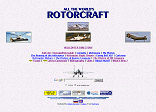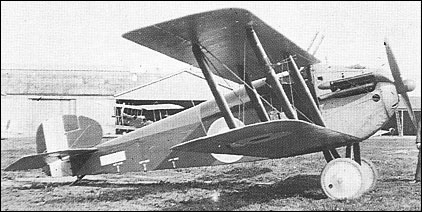|
| Designed to provide the pilot with the best possible
view in tactically important directions, the 5F.1 Dolphin
was unusual in being a two-bay equi-span biplane with
negative stagger. The pilot was seated with his head in
the open framework connecting the upper mainplanes. Primarily of fabric-covered wire-braced wooden construction
with an upper centre section of steel tube, the
Dolphin was powered by a 200hp Hispano-Suiza
geared eight-cylinder water-cooled engine in its initial
production form. Armament consisted of two fixed and
synchronised 7.7mm guns and either one or
two guns of similar calibre mounted over the wing
centre section and movable, but usually firing forwards
and upwards. The prototype was flown in late May
1917, the first production contract was placed in the following
month, on 29 June, and quantity deliveries to
the RFC began late in the year. The first Dolphin squadron
was deployed to France in February 1918, and the
decision was taken to licence-build a version for the US
Air Service in France. This, the Dolphin Mk II powered
by a 300hp Hispano-Suiza engine, was to be manufactured
by the SACA (Societe Anonyme des Constructions
Aeronautiques) and the Air Service anticipated
taking delivery of 2,194 by mid 1919. In the event, only a
few Dolphin Mk Us were completed before the Armistice
prompted cancellation of all contracts. Difficulties
with the reduction gear of the original 200hp engine
led to the conversion of many to direct drive, aircraft fitted with the modified power plant being designated
Dolphin Mk III and some engines having their compression
ratio raised to boost output to 220hp. Production
of the Dolphin totalled 1,532 aircraft, of which all
but 121 were built during 1918. Both Dolphin Mks I and
III were finally withdrawn from RAF service mid 1919.
 | A three-view drawing (1278 x 924) |
| MODEL | Dolphin Mk III |
| WEIGHTS |
| Take-off weight | 907 kg | 2000 lb |
| Empty weight | 665 kg | 1466 lb |
| DIMENSIONS |
| Wingspan | 9.90 m | 33 ft 6 in |
| Length | 6.78 m | 22 ft 3 in |
| Height | 2.59 m | 9 ft 6 in |
| Wing area | 24.46 m2 | 263.28 sq ft |
| PERFORMANCE |
| Max. speed | 206 km/h | 128 mph |
| Klaatu83, e-mail, 24.02.2011 18:49 RAF pilots were prejudiced against this fighter, partly due to the backward stagger of the wings, which reminded many of them of the much-disliked Airco DH-5 fighter. They also disliked having their heads protrude between the upper wings because they of the possible results in case of a nose-over during a bad landing. Since the Dolphin was powered by the unreliable British-built version of the Hispano-Suiza engine, the possibility of a flight ending in bad landing was not considered to be that remote.
However, in combat the Dolphin proved to be a good fighter, and is now regarded as possibly the most underrated fighter type of the First World War. reply |
|
Do you have any comments?
|
| 
COMPANY
PROFILE
All the World's Rotorcraft
|







